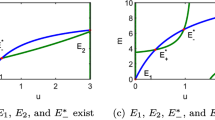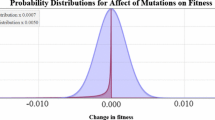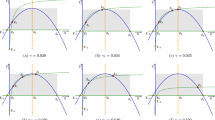Abstract
Mutualisms (reciprocally beneficial heterospecific interactions) are thought as susceptible to exploitation by “cheaters” receiving benefits from partners without fair return. Theoretical studies suggest that partner discrimination is one of the key mechanisms to prevent cheaters from prevailing, but recently, a paradox is suggested that costly partner discrimination might collapse as the result of decreasing in quality variation among potential partners imposed by partner discrimination itself. Here, I develop a simple general mathematical model that consists of two host strains (discriminators/indiscriminators) and two symbiont strains (cooperators/non-cooperators) to establish a framework for the coevolutionary dynamics of mutualisms. First, I present a basic model, a positive equilibrium of which is neutrally stable. Secondly, I derive a formula to describe how the equilibrium shifts with a change in arbitrary parameters: I show a counter-intuitive result that the equilibrium frequency of discriminator hosts decreases as discrimination efficiency increases. Finally, I examine how the equilibrium and its stability changes by adding dependence of fitness of symbionts or hosts on their own frequencies: I find that negative or positive frequency dependence makes the equilibrium asymptotically stable or unstable, respectively. I also find that mutation and immigration of symbionts always make the equilibrium asymptotically stable, even if it does not increase low-quality symbionts.



Similar content being viewed by others
References
Akçay E (2017) Population structure reduces benefits from partner choice in mutualistic symbiosis. Proc R Soc B 284:20162317. https://doi.org/10.1098/rspb.2016.2317
Bennett JA, Maherali H, Reinhart KO, Lekberg Y, Hart MM, Klironomos J (2017) Plant-soil feedbacks and mycorrhizal type influence temperate forest population dynamics. Science 355:181–184. https://doi.org/10.1126/science.aai8212
Bever JD, Richardson SC, Lawrence BM, Holmes J, Watson M (2009) Preferential allocation to beneficial symbiont with spatial structure maintains mycorrhizal mutualism. Ecol Lett 12:13–21. https://doi.org/10.1111/j.1461-0248.2008.01254.x
Brauer F, Castillo-Chavez C (2012) Mathematical models in population biology and epidemiology, 2nd edn. Springer, New York
Bull JJ, Rice WR (1991) Distinguishing mechanisms for the evolution of co-operation. J Theor Biol 149:63–74. https://doi.org/10.1016/S0022-5193(05)80072-4
Denison RF (2000) Legume sanctions and the evolution of symbiotic cooperation by rhizobia. Am Nat 156:567–576. https://doi.org/10.1086/316994
Doebeli M, Knowlton N (1998) The evolution of interspecific mutualisms. PNAS 95:8676–8680
Ezoe H (2009) Dual lattice model of the evolution of facultative symbiosis with continuous Prisoner’s Dilemma game. J Theor Biol 259:744–750. https://doi.org/10.1016/j.jtbi.2009.04.023
Ezoe H, Ikegawa Y (2013) Coexistence of mutualists and non-mutualists in a dual-lattice model. J Theor Biol 332:1–8. https://doi.org/10.1016/j.jtbi.2013.04.016
Ezoe H (2016) Coevolutionary dynamics in one-to-many mutualistic systems. Theor Ecol 9:381–388. https://doi.org/10.1007/s12080-016-0296-x
Ezoe H (2019) Adaptive partner recruitment can help maintain an intra-guild diversity in mutualistic systems. J Theor Biol 478:40–47. https://doi.org/10.1016/j.jtbi.2019.06.017
Foster KR, Kokko H (2006) Cheating can stabilize cooperation in mutualisms. Proc R Sci B 273:2233–2239. https://doi.org/10.1098/rspb.2006.3571
Frederickson ME (2013) Rethinking mutualism stability: cheaters and the evolution of sanctions. Q Rev Biol 88:269–295. https://doi.org/10.1086/673757
Heath KD, Tiffin P (2007) Context dependence in the coevolution of plant and rhizobial mutualists. Proc R Soc B 274:1905–1912. https://doi.org/10.1098/rspb.2007.0495
Heath KD, Tiffin P (2009) Stabilizing mechanisms in a legume-rhizobium mutualism. Evolution 63:652–662. https://doi.org/10.1111/j.1558-5646.2008.00582.x
Heath KD, Stinchcombe JR (2013) Explaining mutualism variation: a new evolutionary paradox? Evolution 68:309–317. https://doi.org/10.1111/evo.12292
Hofbauer J, Sigmund K (1998) Evolutionary Games and Population Dynamics. Cambridge University Press, Cambridge, UK
Janzen DH (1979) How to be a fig. Ann Rev Ecol Syst 10:13–51. https://doi.org/10.1146/annurev.es.10.110179.000305
Kadowaki K, Yamamoto S, Sato H, Tanabe AS, Hidaka A, Toju H (2018) Mycorrhizal fungi mediate the direction and strength of plant–soil feedbacks differently between arbuscular mycorrhizal and ectomycorrhizal communities. Commun Biol 1:196. https://doi.org/10.1038/s42003-018-0201-9
Kiers ET, Rousseau RA, West SA, Denison RF (2003) Host sanctions and the legume-rhizobia mutualism. Nature 425:78–81. https://doi.org/10.1038/nature01931
Kiers ET, Duhamel M, Beesetty Y, Mensah JA, Franken O et al (2011) Reciprocal rewards stabilize cooperation in the mycorrhizal symbiosis. Science 333:880–882. https://doi.org/10.1126/science.1208473
Mcguire KL (2007) Common ectomycorrhizal networks may maintain monodominance in a tropical rain forest. Ecology 88:567–574. https://doi.org/10.1890/05-1173
Pellmyr O, Huth CJ (1994) Evolutionary stability of mutualism between yuccas and yucca moths. Nature 372:257–260. https://doi.org/10.1038/372257a0
Poulin R, Vickery WL (1995) Cleaning symbiosis as an evolutionary game: to cheat or not to cheat? J Theor Biol 175:63–70. https://doi.org/10.1006/jtbi.1995.0121
Rowan R (2004) Coral bleaching: thermal adaptation in reef coral symbionts. Nature 430:742. https://doi.org/10.1038/430742a
Sachs JL, Mueller UG, Wilcox TP, Bull JJ (2004) The evolution of cooperation. Q Rev Biol 79:135–160. https://doi.org/10.1086/383541
Shapiro JW, Turner PE (2014) The impact of transmission mode on the evolution of benefits provided by microbial symbionts. Ecol Evol 4:3350–3361. https://doi.org/10.1002/ece3.1166
Steidinger BS, Bever JD (2014) The coexistence of hosts with different abilities to discriminate against cheater partners: an evolutionary game-theory approach. Am Nat 183:762–770. https://doi.org/10.1086/675859
Travis JMJ, Brooker RW, Clark EJ, Dytham C (2006) The distribution of positive and negative species interactions across environmental gradients on a dual-lattice model. J Theor Biol 241:896–902. https://doi.org/10.1016/j.jtbi.2006.01.025
Uchiumi Y, Ohtsuki H, Sasaki A (2017) Evolutionary emergence and maintenance of horizontally transmitted mutualism that do not rely on the supply of standing variation in symbiont quality. J Evol Biol 30:2211–2221. https://doi.org/10.1111/jeb.13187
West SA, Kiers ET, Pen I, Denison RF (2002a) Sanctions and mutualism stability: when should less beneficial mutualists be tolerated? J Evol Biol 15:830–837. https://doi.org/10.1046/j.1420-9101.2002.00441.x
West SA, Kiers ET, Simms EL, Denison RF (2002b) Sanctions and mutualism stability: why do rhizobia fix nitrogen? Proc R Soc B 269:685–694. https://doi.org/10.1098/rspb.2001.1878
Weyl EG, Frederickson ME, Yu DW, Pierce NE (2010) Economic contract theory tests models of mutualism. Proc Natl Acad Sci USA 107:15712–15716. https://doi.org/10.1073/pnas.1005294107
Yamamura N, Higashi M, Behera N, Wakano JW (2004) Evolution of mutualism through spatial effects. J Theor Biol 226:421–428. https://doi.org/10.1016/j.jtbi.2003.09.016
Author information
Authors and Affiliations
Corresponding author
Ethics declarations
Ethics approval
Not applicable.
Consent to participate
Not applicable.
Consent for publication
Not applicable.
Conflict of interest
The author declares no competing interests.
Appendices
Appendix 1 Local stability of the equilibrium of the basic model
By the definition of equilibrium, φ = ψ = 0 at the equilibrium (H, S) = (H*, S*). In addition, I assume that the finesses of hosts and symbionts are independent from the frequencies of their own strains: ∂φ/∂H = ∂ψ/∂S = 0. From Eq. (4), I have
at the equilibrium (H*, S*). In addition,
because ψH = ∂ψ/∂H > 0 and φS = ∂φ/∂S < 0 at (H*, S*). Then
Equations (22) and (23) indicate that V has a local minimum at (H*, S*). Moreover, from Eqs. (1), (2) and (4),
at any points (H, S). Equation (24) indicates that the value of V is time invariant. Thus (H*, S*) is a neutrally stable equilibrium of Eqs. (1) and (2).
Appendix 2 Effects of frequency dependence on the position of the equilibrium
Let u be a continuous parameter for the degree of frequency dependence of symbiont strains; if u is positive (negative), the degree of the positive (negative) frequency dependence of symbiont strains monotonically increases with the magnitude of u. Functions ψFC and ψFN denote the frequency-dependent fitnesses of cooperator and non-cooperator symbionts, respectively. I assume that they are continuously partially differentiable with respect to u, and that ψFC = ψC and ψFN = ψN (and therefore ψF = ψC-ψN = ψ) when u = 0, where ψC and ψN are frequency-independent fitness functions of cooperator and non-cooperator symbionts, respectively.
The equilibrium of Eqs. (1) and (9) is denoted by (H**, S*). Note that H** = H* when u = 0. Applying the same procedure as Eqs. (5) and (6), I have
where \({\psi }_{H}^{F}=\partial {\psi }^{F}/\partial H\), \({\psi }_{S}^{F}=\partial {\psi }^{F}/\partial S\), \({\psi }_{u}^{F}=\partial {\psi }^{F}/\partial u\), and φu = ∂φ/∂u. As I have assumed φH = φu = 0, then at (H**, S*),
I have also assumed that ψH is positive at (H*, S*), the equilibrium of the frequency-independent system Eqs. (1) and (2). Therefore, if the magnitude of density dependence is sufficiently small, it should be \({\psi }_{H}^{F}>0\) at (H**, S*). Equation (26) indicates that the sign of \(\mathrm{d}\) H**/du is the opposite to the sign of \({\psi }_{u}^{F}\) at the equilibrium, which depends on the detail of the functions ψFC and ψFN.
To consider mutation of symbionts, I set k = μ-/μ+. Then Eq. (17) becomes
Equation (27) is continuously partially differentiable with respect to μ+ and ψF = ψ when μ+ = 0. Therefore, from Eq. (26),
Given ψH > 0 and ψ(H*) = 0, Eq. (28) is followed by Eq. (16).
Similarly, I consider (sufficiently small) positive frequency dependence of host strains with replacing Eq. (2) with
where φF = φFD-φFI. In addition, I introduce a continuous parameter v and assume that φFD and φFI are continuously partially differentiable with respect to v, and that φFD = φD and φFI = φI when v = 0, where φD and φI are frequency-independent fitness functions of discriminator and indiscriminator hosts, respectively. A derivation similar to the above leads to
where (H*, S**) is the equilibrium of Eqs. (2) and (29). Given \({\varphi }_{S}^{F}<0\) at the equilibrium, Eq. (30) indicates that the sign of dS**/dv is the same as the sign of \({\varphi }_{v}^{F}=\partial {\varphi }^{F}/\partial v\) at the equilibrium, which again depends on the detail of the functions φFD and φFI.
Appendix 3 Stability of the equilibrium and frequency dependence of host strains
Here I assume sufficiently small frequency dependence of host fitness on the frequency of its own strain in the population. The sign of the density dependence is the same as the sign of ∂φF/∂H. From Eqs. (2) and (29), I have the following components of the Jacobian matrix at the equilibrium (H*, S**):
If ∂φF/∂H > 0 (positive frequency dependence), it is found from Eqs. (31) and (34) that the trace of the Jacobian matrix.
which indicates that the equilibrium is unstable. On the other hand, if ∂φF/∂H < 0 (negative frequency dependence), Eq. (14) is satisfied so that the equilibrium is asymptotically stable.
Rights and permissions
About this article
Cite this article
Ezoe, H. A general mathematical model for coevolutionary dynamics of mutualisms with partner discrimination. Theor Ecol 15, 203–211 (2022). https://doi.org/10.1007/s12080-022-00537-x
Received:
Accepted:
Published:
Issue Date:
DOI: https://doi.org/10.1007/s12080-022-00537-x




